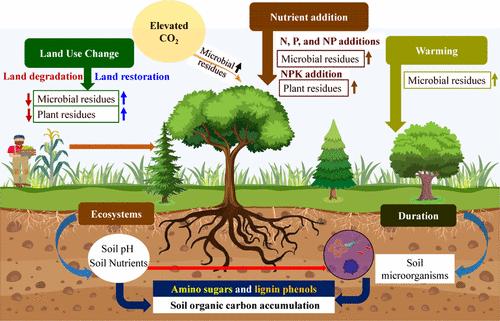全球变化重塑土壤中微生物残留物和植物木质素成分
IF 11.3
1区 环境科学与生态学
Q1 ENGINEERING, ENVIRONMENTAL
引用次数: 0
摘要
微生物碳和植物碳是土壤有机碳(SOC)的重要来源,但土壤氨基糖和木质素酚对全球变化的具体响应尚不清楚。在这项研究中,我们通过553个实验进行了3193次观察,旨在研究氨基糖和木质素酚在应对土地利用变化、营养添加、二氧化碳(eCO2)升高、变暖和干旱时维持有机碳积累的潜在作用。结果表明,土地恢复增加了氨基糖(35.1%)、氨基葡萄糖(53.8%)、半乳糖胺(68.6%)、草酸(33%)、木质素酚类(79.3%)和香草酚类(68%),而土地退化减少了丁香基等化合物。氮(N)和磷(P)的添加提高了氨基糖、氨基葡萄糖和乳酸菌酸的含量,而磷(P)的添加选择性地提高了氨基葡萄糖的含量。添加N、P和钾可提高葡萄糖胺(16.8%)、半乳糖胺(17.3%)、乳酸菌酸(21.6%)和木质素酚(4.8%)含量,而eCO2只提高了14.6%的氨基糖含量。增温使氨基糖和木质素酚含量增加,干旱对氨基糖和木质素酚含量无影响。土壤氨基糖在有机碳积累中的作用比木质素酚更重要,其动态受全球变化下土壤养分有效性和微生物群落的影响。这些发现促进了我们对微生物残留物在营养化学计量学和微生物群落介导的有机碳积累中的主导作用的认识。本文章由计算机程序翻译,如有差异,请以英文原文为准。

Global Change Reshapes Microbial Residues and Plant Lignin Components in Soils
Microbial- and plant-derived carbons are critical sources of soil organic carbon (SOC), but the specific responses of soil amino sugars and lignin phenols to global change remain unclear. In this study, we conducted 3193 observations across 553 experiments aimed at investigating the potential role of amino sugars and lignin phenols in maintaining SOC accumulation in response to land-use change, nutrient additions, elevated C dioxide (eCO2), warming, and drought. The results showed that land restoration increased amino sugars (35.1%), glucosamine (53.8%), galactosamine (68.6%), muramic acid (33%), lignin phenols (79.3%), and vanillyl phenols (68%), whereas land degradation reduced these compounds, including syringyl. Nitrogen (N) and phosphorus (P) additions enhanced amino sugar, glucosamine, and muramic acid contents, whereas P addition selectively increased glucosamine content. N, P, and potassium additions increased glucosamine (16.8%), galactosamine (17.3%), muramic acid (21.6%), and lignin phenol (4.8%) contents, while eCO2 only increased amino sugar content by 14.6%. Warming increased glucosamine and muramic acid contents, whereas drought had no effect on amino sugar and lignin phenol contents. Soil amino sugars played a more critical role than lignin phenols in SOC accumulation, and their dynamics were influenced by soil nutrient availability and microbial communities under global change. These findings advanced our understanding of the dominant role of microbial residues in SOC accumulation mediated by the nutrient stoichiometry and microbial communities.
求助全文
通过发布文献求助,成功后即可免费获取论文全文。
去求助
来源期刊

环境科学与技术
环境科学-工程:环境
CiteScore
17.50
自引率
9.60%
发文量
12359
审稿时长
2.8 months
期刊介绍:
Environmental Science & Technology (ES&T) is a co-sponsored academic and technical magazine by the Hubei Provincial Environmental Protection Bureau and the Hubei Provincial Academy of Environmental Sciences.
Environmental Science & Technology (ES&T) holds the status of Chinese core journals, scientific papers source journals of China, Chinese Science Citation Database source journals, and Chinese Academic Journal Comprehensive Evaluation Database source journals. This publication focuses on the academic field of environmental protection, featuring articles related to environmental protection and technical advancements.
 求助内容:
求助内容: 应助结果提醒方式:
应助结果提醒方式:


